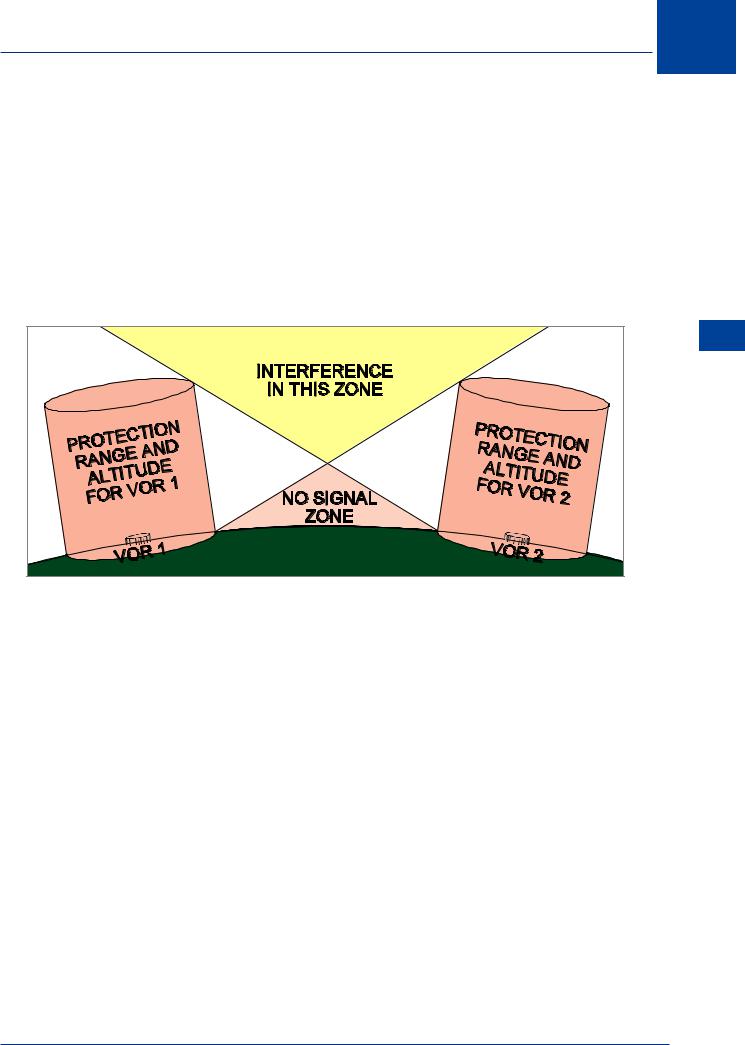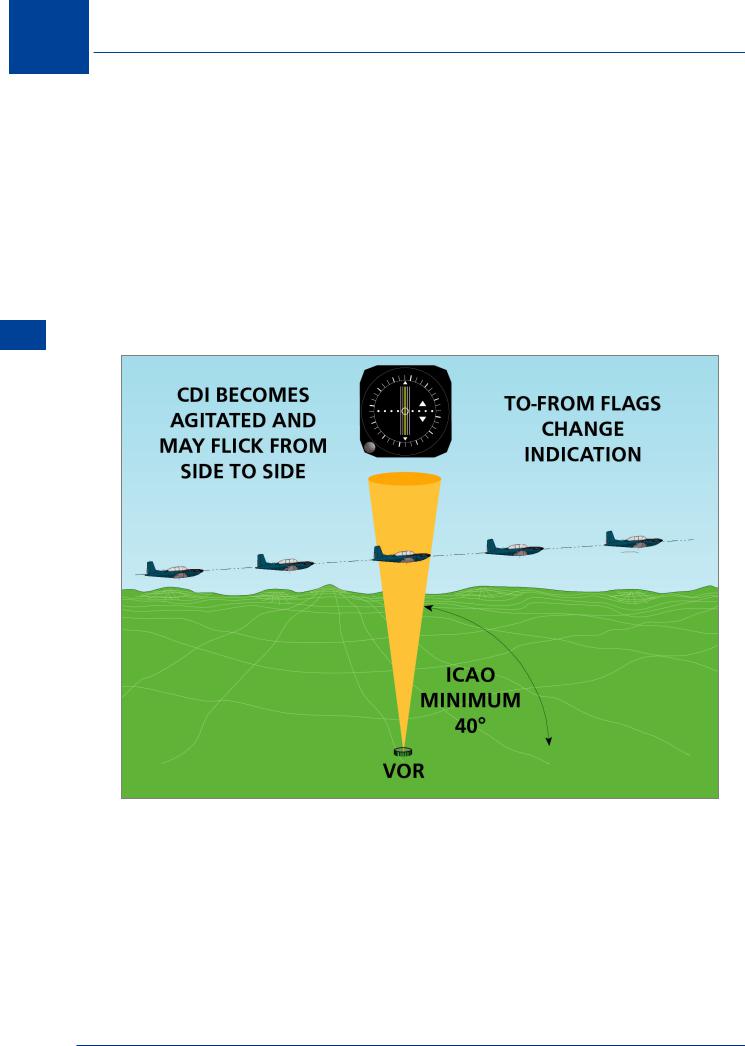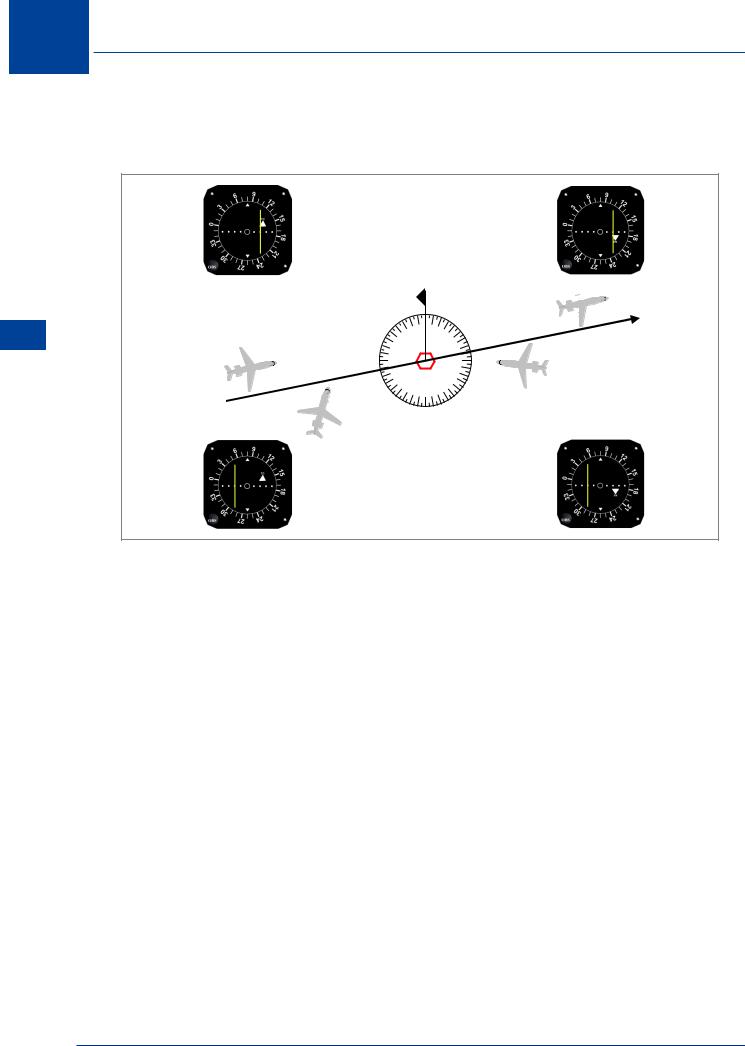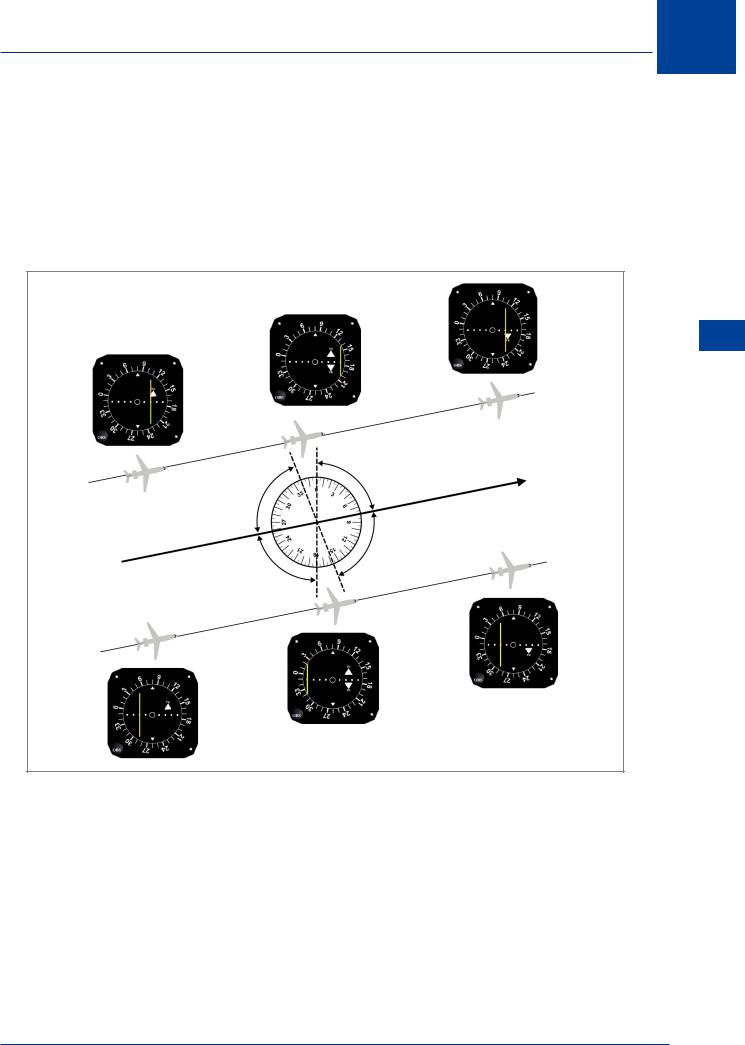
- •Textbook Series
- •Contents
- •1 Properties of Radio Waves
- •Introduction
- •The Radio Navigation Syllabus
- •Electromagnetic (EM) Radiation
- •Polarization
- •Radio Waves
- •Wavelength
- •Frequency Bands
- •Phase Comparison
- •Practice Frequency (
- •Answers to Practice Frequency (
- •Questions
- •Answers
- •2 Radio Propagation Theory
- •Introduction
- •Factors Affecting Propagation
- •Propagation Paths
- •Non-ionospheric Propagation
- •Ionospheric Propagation
- •Sky Wave
- •HF Communications
- •Propagation Summary
- •Super-refraction
- •Sub-refraction
- •Questions
- •Answers
- •3 Modulation
- •Introduction
- •Keyed Modulation
- •Amplitude Modulation (AM)
- •Single Sideband (SSB)
- •Frequency Modulation (FM)
- •Phase Modulation
- •Pulse Modulation
- •Emission Designators
- •Questions
- •Answers
- •4 Antennae
- •Introduction
- •Basic Principles
- •Aerial Feeders
- •Polar Diagrams
- •Directivity
- •Radar Aerials
- •Modern Radar Antennae
- •Questions
- •Answers
- •5 Doppler Radar Systems
- •Introduction
- •The Doppler Principle
- •Airborne Doppler
- •Janus Array System
- •Doppler Operation
- •Doppler Navigation Systems
- •Questions
- •Answers
- •6 VHF Direction Finder (VDF)
- •Introduction
- •Procedures
- •Principle of Operation
- •Range of VDF
- •Factors Affecting Accuracy
- •Determination of Position
- •VDF Summary
- •Questions
- •Answers
- •7 Automatic Direction Finder (ADF)
- •Introduction
- •Non-directional Beacon (NDB)
- •Principle of Operation
- •Frequencies and Types of NDB
- •Aircraft Equipment
- •Emission Characteristics and Beat Frequency Oscillator (BFO)
- •Presentation of Information
- •Uses of the Non-directional Beacon
- •Plotting ADF Bearings
- •Track Maintenance Using the RBI
- •Homing
- •Tracking Inbound
- •Tracking Outbound
- •Drift Assessment and Regaining Inbound Track
- •Drift Assessment and Outbound Track Maintenance
- •Holding
- •Runway Instrument Approach Procedures
- •Factors Affecting ADF Accuracy
- •Factors Affecting ADF Range
- •Accuracy
- •ADF Summary
- •Questions
- •Answers
- •8 VHF Omni-directional Range (VOR)
- •Introduction
- •The Principle of Operation
- •Terminology
- •Transmission Details
- •Identification
- •Monitoring
- •Types of VOR
- •The Factors Affecting Operational Range of VOR
- •Factors Affecting VOR Beacon Accuracy
- •The Cone of Ambiguity
- •Doppler VOR (DVOR)
- •VOR Airborne Equipment
- •VOR Deviation Indicator
- •Radio Magnetic Indicator (RMI)
- •Questions
- •In-flight Procedures
- •VOR Summary
- •Questions
- •Annex A
- •Annex B
- •Annex C
- •Answers
- •Answers to Page 128
- •9 Instrument Landing System (ILS)
- •Introduction
- •ILS Components
- •ILS Frequencies
- •DME Paired with ILS Channels
- •ILS Identification
- •Marker Beacons
- •Ground Monitoring of ILS Transmissions
- •ILS Coverage
- •ILS Principle of Operation
- •ILS Presentation and Interpretation
- •ILS Categories (ICAO)
- •Errors and Accuracy
- •Factors Affecting Range and Accuracy
- •ILS Approach Chart
- •ILS Calculations
- •ILS Summary
- •Questions
- •Answers
- •10 Microwave Landing System (MLS)
- •Introduction
- •ILS Disadvantages
- •The MLS System
- •Principle of Operation
- •Airborne Equipment
- •Question
- •Answer
- •11 Radar Principles
- •Introduction
- •Types of Pulsed Radars
- •Radar Applications
- •Radar Frequencies
- •Pulse Technique
- •Theoretical Maximum Range
- •Primary Radars
- •The Range of Primary Radar
- •Radar Measurements
- •Radar Resolution
- •Moving Target Indication (MTI)
- •Radar Antennae
- •Questions
- •Answers
- •12 Ground Radar
- •Introduction
- •Area Surveillance Radars (ASR)
- •Terminal Surveillance Area Radars
- •Aerodrome Surveillance Approach Radars
- •Airport Surface Movement Radar (ASMR)
- •Questions
- •Answers
- •13 Airborne Weather Radar
- •Introduction
- •Component Parts
- •AWR Functions
- •Principle of Operation
- •Weather Depiction
- •Control Unit
- •Function Switch
- •Mapping Operation
- •Pre-flight Checks
- •Weather Operation
- •Colour AWR Controls
- •AWR Summary
- •Questions
- •Answers
- •14 Secondary Surveillance Radar (SSR)
- •Introduction
- •Advantages of SSR
- •SSR Display
- •SSR Frequencies and Transmissions
- •Modes
- •Mode C
- •SSR Operating Procedure
- •Special Codes
- •Disadvantages of SSR
- •Mode S
- •Pulses
- •Benefits of Mode S
- •Communication Protocols
- •Levels of Mode S Transponders
- •Downlink Aircraft Parameters (DAPS)
- •Future Expansion of Mode S Surveillance Services
- •SSR Summary
- •Questions
- •Answers
- •15 Distance Measuring Equipment (DME)
- •Introduction
- •Frequencies
- •Uses of DME
- •Principle of Operation
- •Twin Pulses
- •Range Search
- •Beacon Saturation
- •Station Identification
- •VOR/DME Frequency Pairing
- •DME Range Measurement for ILS
- •Range and Coverage
- •Accuracy
- •DME Summary
- •Questions
- •Answers
- •16 Area Navigation Systems (RNAV)
- •Introduction
- •Benefits of RNAV
- •Types and Levels of RNAV
- •A Simple 2D RNAV System
- •Operation of a Simple 2D RNAV System
- •Principle of Operation of a Simple 2D RNAV System
- •Limitations and Accuracy of Simple RNAV Systems
- •Level 4 RNAV Systems
- •Requirements for a 4D RNAV System
- •Control and Display Unit (CDU)
- •Climb
- •Cruise
- •Descent
- •Kalman Filtering
- •Questions
- •Appendix A
- •Answers
- •17 Electronic Flight Information System (EFIS)
- •Introduction
- •EHSI Controller
- •Full Rose VOR Mode
- •Expanded ILS Mode
- •Full Rose ILS Mode
- •Map Mode
- •Plan Mode
- •EHSI Colour Coding
- •EHSI Symbology
- •Questions
- •Appendix A
- •Answers
- •18 Global Navigation Satellite System (GNSS)
- •Introduction
- •Satellite Orbits
- •Position Reference System
- •The GPS Segments
- •The Space Segment
- •The Control Segment
- •The User Segment
- •Principle Of Operation
- •GPS Errors
- •System Accuracy
- •Integrity Monitoring
- •Differential GPS (DGPS)
- •Combined GPS and GLONASS Systems
- •Questions
- •Answers
- •19 Revision Questions
- •Questions
- •Answers
- •Specimen Examination Paper
- •Appendix A
- •Answers to Specimen Examination Paper
- •Explanation of Selected Questions
- •20 Index

VHF Omni-directional Range (VOR) 8
Transmitter power, propagation paths and the degree of co-frequency interference protection required, necessitate co-frequency beacons to be separated for planning purposes by an extra 100 NM to about 500 NM. In practice, a beacon is protected as far as is deemed necessary and this is not always the anticipated line of sight reception range.
In the UK this protection is denoted by a DOC, specified as a range and altitude, e.g a DOC of 50/25 published in AIPs means that an aircraft should not experience co-frequency interference within 50 NM of a VOR beacon, up to a height of 25 000 ft. The DOC may also vary by sectors and it is valid day and night. Use of a VOR outside its DOC can lead to navigation errors. Refer to the latest AIC.
Note: When super-refraction conditions exist interference may be experienced within the DOC.
VHF Omni-directional Range (VOR) 8
Figure 8.7 Designated Operational Coverage.
VOR 1: DOC 50/25 = No interference within 50 NM range up to 25 000 ft.
VOR 2: DOC 100/50 = No interference within 100 NM range up to 50 000 ft.
Factors Affecting VOR Beacon Accuracy
Site error is caused by uneven terrain such as hills and man-made structures, trees and even long grass, in the vicinity of the transmitter. The error to radiated bearings is termed ‘VOR course-displacement error’. Ground VOR beacon site error is monitored to ± 1° accuracy.
Propagation error is caused by the fact that, having left the VOR site with ±1° accuracy, the transmissions are further affected by terrain and distance. At considerable range from the VOR, ‘bends’ or ‘scalloping’ can occur. VOR scalloping is defined as an imperfection or deviation in the received VOR signal. It causes the signal to 'bend' as a result of reflections from buildings or terrain; it causes the Course Deviation Indicator to slowly or rapidly shift from side to side.
Airborne equipment errors are caused by aircraft equipment assessing and converting the phase differences to 1° of bearing; maximum aircraft equipment error should be ± 3°.
The above errors are aggregated to give a total error of ± 5°. In addition there is pilotage error due to the fact that as an aircraft approaches the VOR the 1° radials get closer together.
117

8 VHF Omni-directional Range (VOR)
(VOR) Range directional-Omni VHF 8
The Cone of Ambiguity
As the VOR is approached, the radials converge and the VOR needle becomes more sensitive. Near the VOR overhead the needle oscillates rapidly and the ‘OFF’ flag may appear momentarily; also the ‘TO/FROM’ display alternates. This is all caused by the cone where there is no planned radiation. This is known as the cone of ambiguity or confusion. Once the aircraft has flown through this cone the readings at the aircraft will stabilize.
Coverage
The VOR shall provide signals to permit satisfactory operation of a typical aircraft installation at the levels and distances required for operational reasons, and up to a minimum elevation angle of 40°. In practice, modern VOR beacons are capable of providing usable signals within 60° to 80° above the horizon.
Figure 8.8 The Cone of Confusion
Doppler VOR (DVOR)
Doppler VORs are second generation VORs. Although their transmission frequencies are the same, the transmitted bearing accuracy is improved as the transmissions are less sensitive to site error.
The transmission differences are:
•The reference signal is AM.
•The variable phase directional signal is FM.
118

VHF Omni-directional Range (VOR) 8
•To maintain the phase relationships which exist in conventional VOR transmissions, the (apparent or simulated) rotation of the directional signal is anti-clockwise. As a result the same airborne VOR equipment can be used with either CVOR or DVOR beacons.
VOR Airborne Equipment
There are 3 main components of the VOR equipment in the aircraft, namely:
•Aerial. For slower aircraft the aerial is a whip type fitted on the fuselage and for high speed aircraft it is a blade type or is flush mounted on either side of the vertical fin.
•Receiver. This is a box fitted in the avionics bay.
•Indicator. Information derived from the VOR signal received at the aircraft may be fed to a flight director system or to the more simple displays such as the CDI (course deviation indicator) or the RMI (radio magnetic indicator). These are described below.
VOR Deviation Indicator
This instrument displays VOR information, and is widely used in light aircraft. The instrument indicates the displacement of the aircraft with respect to a bearing (to or from the VOR station) which has been selected on the Course Selector Knob or OBS (Omni-bearing Selector). See
Figure 8.9.
|
6 |
|
9 |
|
|
|
|
|
|
|
|
|
TO |
15 |
|
|
|
||
0 |
|
|
|
|
|
|
|
|
|
33 |
|
|
|
18 |
|
|
FR |
|
|
|
|
|
|
21 |
OBS |
|
27 |
24 |
|
|
|
|||
|
|
|
|
Figure 8.9 VOR/ILS Deviation Indicator
The indicator drawn in Figure 8.10 is typical with the azimuth scale having a circle and four dots on each side of the centre. As the circle itself counts as the first dot this is a five dot display with each dot indicating approximately a 2° displacement from the selected VOR bearing. Full scale deflection therefore represents 10°.
This displacement (or deviation) is presented by a deviation bar on the indicator. Figure 8.10 shows that the displacement of the bar depends on the angular position of the beacon relative to the selected bearing and is independent of the way the aircraft is pointing. In other words, for a given position and bearing selection, the heading of the aircraft does not affect the display on a deviation indicator.
VHF Omni-directional Range (VOR) 8
119

8 VHF Omni-directional Range (VOR)
(VOR) Range directional-Omni VHF 8
Inspection of Figure 8.10 shows that aircraft at positions 1 and 3 receive a Fly Right indication. If the aircraft lay exactly on the selected bearing either to or from the station, the deviation bar would be central.
3 
|
|
0 |
3 |
Course Set 080° |
|
33 |
|
||
|
|
|
||
1 |
30 |
|
6 |
|
|
27 |
|
9 |
|
|
24 |
|
12 |
4 |
|
21 |
18 |
15 |
|
|
|
|
||
|
2 |
|
|
|
|
|
|
|
Figure 8.10 Left/Right Indications
Aircraft at positions 2 and 4 both receive a Fly Left indication (deviation bar to the left of centre) but note that the aircraft at position 4 must turn to the right to reduce its displacement from the selected line. The deviation bar ‘sense’ is wrong for the aircraft at position 4, and this is generally undesirable. To keep the deviation bar sense correct when flying a track to or from a VOR station, the aircraft’s heading should be about the same as the track selected on the Omni-bearing Selector (plus or minus any drift allowance).
As the equipment normally includes an automatic To/From flag the rule to be followed to keep the deviation bar sense correct is that:
When inbound to a VOR, select the inbound track on the OBS, so that a ‘TO’ indication appears. When outbound from a VOR, select the outbound track on the OBS so that a ‘FROM’ indication is seen.
120

VHF Omni-directional Range (VOR) 8
In addition to the Left/Right display, the deviation indicator shows a ‘TO’ or a ‘FROM’ flag depending on whether:
•The aircraft’s QDM is within about 80° of the bearing selected, in which case ‘TO’ appears
•The aircraft’s QDR is within about 80° of the bearing selected, in which case ‘FROM’ appears
This leaves two sectors about 20° wide in which an indeterminate TO/FROM indication is obtained.
VHF Omni-directional Range (VOR) 8
Figure 8.11 To/From Indications
Figure 8.11 depicts the deviation indicator in the various sectors about the VOR beacon. It should be remembered that the six indications in Figure 8.11 are completely independent of the aircraft’s heading. They depend on the aircraft’s bearing from the beacon and on the bearing which has been selected on the OBS.
If the VOR transmissions are faulty or the aircraft is out of range or the airborne power supply is inadequate, an ‘OFF’ flag appears.
121
